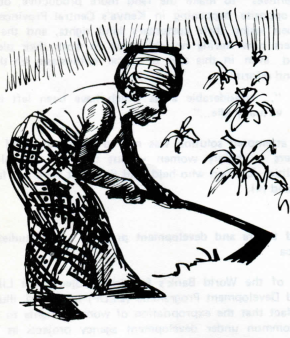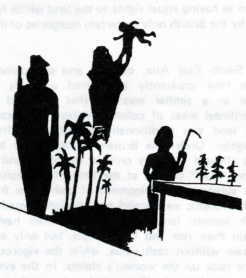Women and land rights
Barbara Rogers
Women lose their rights to land
Modern western laws see land ownership as an individual affair, with built-in incentives for the individual to work the land in order to maximise profit for him or herself. Common rights to land have dwindled to a tiny remnant of their former importance. Family property has been vested in the hands of the senior male. Curiously enough, this tide is only now beginning to turn with the concept of jointly owned property in a marriage partnership, and the development of various forms of cooperative ownership in which several people share responsibility for house or land.n the world of "development" projects and policies, however, individualism reigns supreme, untouched by even the concept of wives sharing property with their husbands. Land registration and reform is almost everywhere concerned with replacing systems of co-ownership with the concept of individual title to land, bestowed on the person seen as the "head of household" which in turn is invariably a man unless the household in question is "headed" by a widow, single mother or other man-less woman. The hierarchical principle whereby even a family has to have a "head" is deeply entrenched in development thinking, data collection and planning.
The fear of matriliny
Because the official development philosophy, taking its cue perhaps from anthropology, assumes a basic principle of society to be the dominance of one person over others - and the dominance being invariably vested in men - it is apparently a matter of great anxiety to western- trained planners to encounter a matrilineal, matrilocal or mixed society. This represents a contradiction of their basic assumptions about male supremacy (1), perhaps exacerbated by the fact that matrilineal systems are much less hierarchical than most patrilineal ones, with prestige based on personal accomplishment rather than membership in a particular family (2).
The attack on women's land rights
A Kenyan sociologist, Achola Pala, has suggested that in pre-colonial pastoral or agricultural economies, women could usually protect their own economic interests because their "usufruct" rights in land and cattle were well defined, and actually were more effective than individual ownership would be. Usufruct, or the right to use, extended not only to the land itself but to other vital resources such as fish, game, salt licks, water, herbs, vegetables, fruits, fuel, clay and thatch. This ensured the economic rights of all kinds of people who could be squeezed out of a system of formal ownership: women, men, children, old people and the handicapped. In addition, since productive work was of more importance than formal ownership, the system guaranteed access to resources for all those who worked (3). In fact, there was a much stronger incentive to work the land, and to care for its long-term fertility, than exists under a system of outright ownership which persists even if the land is over-exploited for short-term profit or left derelict. John C. de Wilde, writing about colonial changes in land tenure designed to create "incentives" to make the land more productive, observed the opposite happening in Kenya's Central Province. With women losing their customary land rights, and the right holders now having no obligation to work their plots. He noted even in this area of local enthusiasm for the idea of land reform
"... considerable areas which have been left idle or virtually idle..."
The attempted solution was not to return the land to the farmers - mainly women - but to devise special fiscal penalities for men who held land titles but were not farming the land (4).
Land tenure and development projects: case studies from Africa
One of the World Bank's favourite projects, the Lilongwe Land Development Programme (LLDP) in Malawi, illustrates the fact that the expropriation of women's rights to land is as common under development agency projects as it was under colonial administration. Under British rule, Village Reorganisation Schemes had been devised in what was then Nyasaland, intended as an integrated programme for land consolidation and technical improvements in land use; by 1958/59 this programme had been applied to some 200,000 acres. During the next few years, however, the entire scheme had to be abandoned due to opposition from the local people. Among other mistakes, the colonial Department of Agriculture apparently assumed that the consent of the (usually male) chief was enough to indicate support from the whole area. John de Wilde, summing up the disaster, comments that there had been particular problems in obtaining the cooperation of the women who, in the matrilineal society prevailing in the affected areas, were of critical importance in any land reform and who were, he suggests, "needlessly alienated" by the way in which land redistribution was carried out ( 5 ).
LLDP might be described as an updated version of this programme, now called integrated rural development. It also serves as a model for the World Bank's new policy, which stresses involvement of small farmers and a generally " integrated" package. A Bank document states:
" The significance of LLDP for the IBRD is that the project typifies one of the Bank's two principal strategies for what are called 'integrated smallholder development programs'... ( 6 ) " .
LLDP management has determined, to its own satisfaction at least, that matriliny and the associated system of " socialistic " distribution among an extended family is as good as extinct . Actual residence patterns indicate that it is very much alive. The administration is carrying out a programme of land registration to entrench ownership in a family " leader " ; this is within the framework of Malawi government legislation of 1967, based on western models, which provides the legal and institutional framework for the classification and registration of land in the hands of a relatively small number of men. The official objectives of the LLDP programme are to entrench individual "security " in ownership of land regardless of the use made of it; and this in turn will be the avenue t o credit and other inputs offered by LLDP. Now however, there are reports of considerable local opposition to the programme, hardly surprising in view of the fact that people's land is in effect being expropriated.
It is in resettlement schemes, however, where a completely new system of land tenure applies, that women lose o u t most drastically. Jane Hanger's studies at an irrigated rice settlement at Mwea, in Kenya, show that: " . . . the Settlement procedures treat the male head of household as if he were the principal labourer and decision-maker for the irrigated fields farmed under a tenancy agreement w i t h him, whereas both traditionally and in present practice the women contribute the larger share of farm work within the cultivation system ( 7 ) " .
Having lost their right to land on which to grow the family's food , as well as being excluded f r om the system of cash payments for rice production , the women found the scheme an unpleasant place to live and work , in spite of all the government services available there and not elsewhere. The project as a whole was undermined by the women's refusal to devote the time needed to the rice crop, and their black-market trading in rice, the only source of income for them (8). Another , even more drastic response was for women to abandon the settlement scheme altogether; the researchers explained that " many women have found Mwea an intolerable place to live " (9).
A similar problem is described by James Brain in relation to a settlement scheme in Tanzania, where women accustomed to having rights to land were suddenly deprived of them and all the proceeds of land and labour were handed over to their husbands or fathers. At one scheme at Kingurungundwa women had revolted against what Brain describes as " Virtual serfdom" and demanded their land rights. The government's response was not encouraging; instead of resolving the women's problems it closed down the scheme shortly afterwards (10).
Yet another example of this pattern is the resettlement programme of the Upper Volta government agency, the Autori te des Amenagements des Vallees des Volta ( A W ) . Faced with demands for exceptionally hard work on the cash crops owned by the men, and deprived of the means of growing their family's food or earning money by trading, women were unable to feed their children, according to a study by a Voltaic sociologist, Jacqueline Gissou: "since women had no personal resources they are forced to condemn their children to constant hunger (11)". It is not generally expected of the menfolk that they use cash income to feed their children. The result seems to be similar to that at Mwea: complaints from the women, a succession of departures by some of them, followed by their husbands who cannot an age the work alone, and threats from others to leave the scheme also (12).
A worldwide phenomenon
It is not only in Africa that women have lost their rights to land. That continent offers perhaps the most examples of this happening now, since in Asia and Latin America the process advanced much further under colonial rule and legislation along western lines has dispossessed women on a massive scale. Indeed, for many areas women's history of land rights has largely been forgotten. India is a classic case of this: the land tenure systems of zamindari and ryotwari are those imposed by the British colonial administration, in alliance with the big landowners (13).
In other Asian countries, land tenure is much more flexible than in India and might reflect patterns of land use which prevailed there before British rule. Women have well - recognised rights to land. In Ceylon after the Second World War for example, a colonial settlement scheme selected only married men with children as participants; but when required to nominate a successor, 19 out of 43 of these men nominated a son, 13 a daughter and 7 a wife (14). In effect, women were seen as having equal rights to the land which had been allocated by the British only to certain categories of men
In South East Asia, colonial and post-colonial administration have apparently transferred women's land rights to men in a similar way to that observed in Africa. In matrilineal areas of colonial Malaya, for example, much of the land was traditionally passed down from mother to daughter. Under the British "reform", the traditional code was allowed to apply only in regard to land seen as falling under "clan" control at the time of the registration of land. The subsequent development of cash crops from rubber and fruit orchards was carried out on plots owned by individuals, with women largely excluded. Women have managed to retain their rice and house plots, but only as long as these remain without cash value, while the vigorous family traditions back up the women's claims. In the event of women's plots acquiring significant cash value, as happens with commercialisation or "development", no legal remedies are available to the women to enforce their rights there (15).
In Latin America, women have virtually no claim to land on the basis of traditional rights, since land was from the beginning of colonial conquest and rule the focus of increasing demand by European settlers and commercial interest.
It was acquired, with little respect for any body of law, by merced (grant from the authorities), conquest, violent expulsion of native Americans from their land, and later also of mestizo and even white homesteaders from their private lands. Gunder Frank describes land claims as having been staked out by a variety of more or less fraudulent means, with the "cash nexus", derived from profits in mining and commerce, ruling the land in Latin America right from the beginning of colonial rule there (16
Perhaps the only comprehensive survey of trends regarding women's rights to land in this continent is the study by Patricia Garrett of the situation in Chile between 1935 and the present. Under Chilean law, a woman's property passes to the control of her husband on marriage, except in rare cases where expensive legal precautions are taken to prevent this. The law is closely modelled on 19th century European concepts in this respect; the 1964 Civil Code indicated that "the potestad marital is the set of rights that the laws grant to the husband over the person and goods of the woman (17)': The Allende government in Chile, which laid considerable stress on land reform, failed to tackle this system; it remains in force, of course, under the present right-wing government. Failure to represent women's interests was probably an important mistake on the part of the Allende government, and left a vacuum which allowed right-wing propaganda to be particularly effective among certain groups of women
Right and left-wing attempts at changes in land tenure have all, up to now, hastened the process of dispossessing women who are working farmers, exacerbating the flight to the cities which in Latin America and some countries elsewhere have many more women in their vast slums than men; elsewhere, where colonial laws excluded women from the cities, the balance is beginning to change in the same direction. As Patricia Garrett observes in relation to Chile, it is "practically impossible" for a woman to maintain herself and her children in the countryside if she has no adult male in the household (18). Faced with destitution, the only way to survive is in too many cases prostitution or — often similar — domestic work in the cities. Land "reform", often so well intentioned, is driving women, the poorest of the poor, from the land. Until it is radically changed to ensure their full participation, those who advocate it should be vigorously opposed
Footnotes
1. See e.g. Maurice Godelier, 1977, Perspectives in Marxist anthropology. Translated from the French by Robert Brain. Cambridge Studies in Social Anthropology 18 (Cambridge; Cambridge University Press) pp. 105-6. The concepts here apparently originate with Claude Levi-Strauss, with his "absolute priority of patrilineal institutions over matrilineal institutions", and permeate more conventional as well as Marxist approaches. Claude Levi-Strauss, 1969, The elementary structures of kinship. Translated from the French by James Harle Bell, John Richard von Sturmer and Rodney Needham (London: Eyre and Spottiswoode) p. 116.
2. See Mary Douglas, 1969, "Is matriliny doomed in Africa?" in Mary Douglas and Phyllis M. Kaberry (eds.), Man in Africa, (sic) (London: Tavistock Publications).
3. Achola A. Pala, 1976, African women in rural development: research trends and priorities, OLC Paper No. 12. (Washington DC: Overseas Liaison Committee, American Council on Education) pass/'/n.
4. John C. de Wilde, 1967, Experiences with agricultural development in tropical Africa, Vol. 1: The synthesis. Published for the International Bank for Reconstruction and Development (Baltimore: The Johns Hopkins University Press) p. 142.
5. de Wilde, O/D. c/f. pp. 140-41. 6. Bill H. Kinsey, 1974, Rural development in Malawi: a review of the Lilongwe Land Development Program. African Rural Development Study Background Paper (Washington DC: IBRD. Mimeo) p. 1.
6. Bill H. Kinsey, 1974, Rural development in Malawi: a review of the Lilongwe Land Development Program. African Rural Development Study Background Paper (Washington DC: IBRD. Mimeo) p. 1.
7. Jane Hanger and Jon Morris, 1973, "Women and the household economy" in Robert Chambers and Jon Morris(eds.) Mwea: an irrigated rice settlement in Kenya, Ifo — Institute fur Wirtschaftsforschung, Afrika Studien 83 (MiJnchen: Weltforum) pp. 210-11.
8. Ibid., passim.
9. pp. 124-25.
10. James L. Brain, 1976, "Less than second-class", in Nancy J. Hafkin and Edna G. Bay (eds.). Women in Africa: studies in social and economic change (Stanford, Calif.: Stanford University Press) pp. 275, 279.
11. Societe Africaine d'Etudes de Developpement (SAED), 1977, Etude sur les besoins des femmes dans les villages de I'A.V.V. et proposition d'un programme d'intervention (Ouagadougou: Autorite' des Amenagements des Vallees des Volta, Ministere du Developpement Rural) p. 32. Translation by the author.
12. Ibid.,p.G.
13. See Margaret Haswell, ^QGl, Economics of development in village India (London: Routledge and Kegan Paul) Chapter 1. Also Guy Hunter, 1970, The administration of agricultural development: lessons from India (London: Oxford University Press) p. 20.
14. B.H. Farmer, 1957, Pioneer peasant colonization in Ceylon (London: Oxford University Press) pp. 207, 290.
15. M.G. Swift, 1964, "Capital, saving and credit in a Malay peasant economy", in Raymond Firth and E.S. Yamey (eds.). Capital, saving and credit in peasant societies: studies from Asia, Oceania, the Caribbean and Latin America (London: George Allen and Unwin) pp. 147-48.
16. Andre Gunder Frank, 1969, Capitalism and underdevelopment in Latin America: historical studies of Chile and Brazil (New York: Monthly Review Press) p. 28.
17. Patricia M. Garrett, 1976, Some structural constraints on the agricultural activities of women: the Chilean hacienda. Research Paper No. 70 (Madison, Wise: Land Tenure Center) p. 28.
18. Ibid., pp. 1,36.

